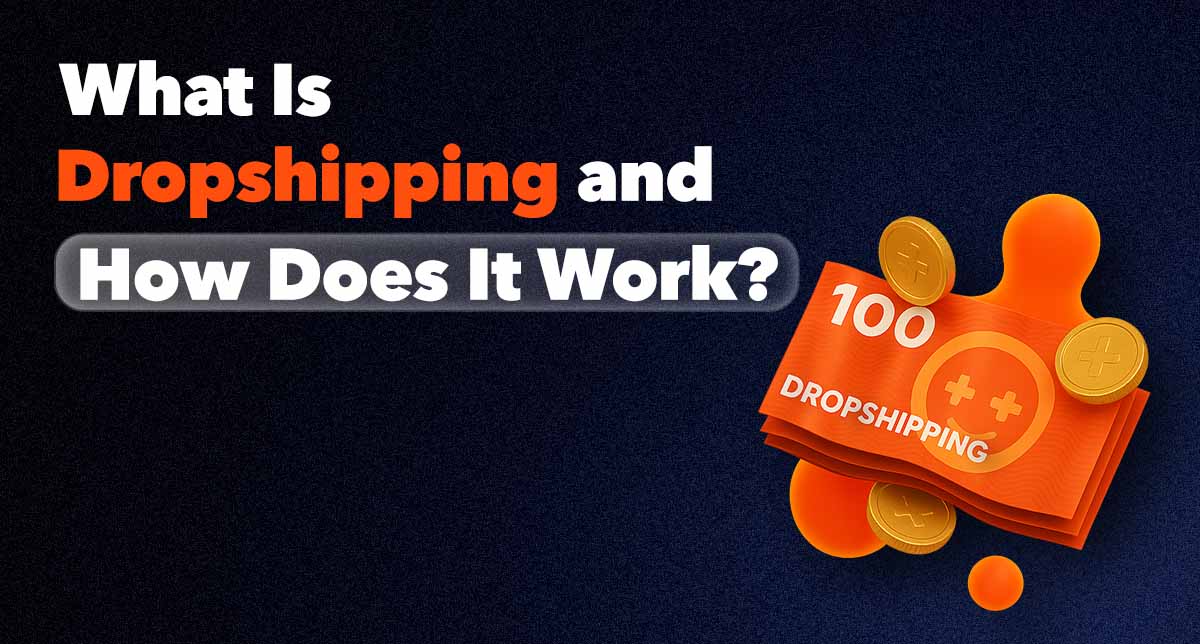Dropshipping has emerged as one of the most popular and low-barrier-to-entry business models in e-commerce. It allows entrepreneurs to start an online store without the burden of managing inventory or handling shipping logistics. In a typical dropshipping business, you act as the middleman between the customer and the supplier, selling products without ever physically holding stock. When a customer places an order, the supplier ships the product directly to the customer’s address.
This model seems simple, but there are many nuances and challenges involved. It’s important to understand the full process, especially if you’re new to the world of dropshipping. In this blog, we will dive into what dropshipping is, how it works, common mistakes beginners make, and the essential services you should outsource to experts to run a successful business. We'll also explore strategies for niche selection, supplier vetting, customer retention, and the importance of legal and financial considerations. Let’s explore how you can build a thriving dropshipping business in 2025.



How Dropshipping Works: The Full Process Explained
If you're just starting with dropshipping, it’s crucial to understand the entire process from start to finish. Here’s a step-by-step breakdown of how the dropshipping business model works:1. Setting Up Your Online Store: Laying the Foundation
The first and arguably most crucial step in the dropshipping process is establishing your online storefront. This digital shop serves as the primary interface between your products and your potential customers. You’ll need to select a suitable e-commerce platform to host your store, with Shopify, WooCommerce (for WordPress users), and BigCommerce being popular and robust options. These platforms offer intuitive interfaces and extensive customization features, allowing you to create and design your website with relative ease, even if you have no prior experience in web development or graphic design. Beyond the technical setup, the strategic elements of store creation are paramount. You must diligently choose a niche that not only aligns with your interests or expertise but also demonstrates significant market potential and demand. Thorough market research, including analyzing trending products, competitor analysis, and identifying underserved customer segments, is critical here. Once your niche is defined, you can begin the curated process of adding products to your store. This involves writing compelling product descriptions, capturing high-quality images, and ensuring all product information is accurate and enticing. Remember, your store's aesthetic and user experience directly impact conversion rates and customer trust.2. Finding Reliable Suppliers: The Backbone of Your Business
Once your store is set up and your product catalog is taking shape, the next vital step is to find reliable suppliers. These suppliers are the linchpin of your dropshipping operation; they are responsible for storing the products, managing inventory, fulfilling orders, and, crucially, shipping them directly to your customers. Platforms like AliExpress, Oberlo (often integrated with Shopify), SaleHoo, and Wholesale2B are excellent starting points for discovering a vast array of potential suppliers across various product categories. Building strong, transparent relationships with your suppliers is paramount, as the ultimate success and reputation of your business heavily depend on their performance. When vetting potential suppliers, prioritize those with a proven track record, consistently high-quality products, competitive pricing, and, most importantly, fast and reliable shipping times. Many dropshipping platforms offer seamless integrations that allow you to easily import products, synchronize inventory levels, and automate order fulfillment, streamlining your operational workflow. It's also wise to inquire about their return policies and customer service responsiveness, as these factors will directly impact your ability to provide excellent service to your customers.3. Customer Places an Order: The Transaction Initiates
This is where your marketing efforts translate into tangible results. When a customer visits your impeccably designed online store, browses your product offerings, and decides to make a purchase, they initiate the transaction. You, as the store owner, collect the payment directly from the customer. Once the payment is successfully processed, the order details—including the customer's shipping address, chosen product(s), and quantity—are then securely forwarded to your designated supplier. This crucial step effectively removes the need for you to handle any physical inventory, manage warehousing, or engage in packaging and shipping logistics, highlighting one of the primary and most attractive advantages of the dropshipping model. At this juncture, your profitability comes into play. You make a profit based on the difference between the retail price the customer paid on your website and the wholesale price you paid to your supplier for the product. You retain complete control over the markup you apply to each product, allowing you to strategically price your items to ensure both competitiveness and healthy profit margins. This direct payment flows from the customer to you and then from you to the supplier and is the financial engine of your dropshipping business.4. Forwarding the Order to the Supplier: Seamless Fulfillment
Following the customer's successful order placement and payment, your next immediate action is to accurately and promptly forward these order details to your chosen supplier. From this point onward, the supplier assumes full responsibility for the fulfillment process. This includes meticulously picking the ordered product(s) from their warehouse, securely packaging them, and arranging for shipment. A significant number of dropshipping platforms offer advanced automation features, which can automatically transmit new orders directly to your suppliers, significantly reducing manual effort and minimizing the risk of errors or delays. Maintaining clear and consistent communication with your suppliers is absolutely vital to prevent any potential delays in order fulfillment or shipping. Proactive communication helps in resolving any unforeseen issues swiftly. Equally important is setting transparent and realistic expectations with your customers regarding shipping times. Whether the product is shipping domestically or internationally, clearly communicating estimated delivery windows upfront can significantly enhance customer satisfaction and reduce inquiries or complaints. Timely updates to customers about their order status also foster trust and improve the overall buying experience.5. Customer Receives the Product: The Final Link
Once the product has been dispatched by the supplier, it embarks on its journey directly to your customer's specified address. The duration of this delivery process can vary considerably, ranging from a few days to several weeks, depending on the chosen shipping method, the origin of the product, and the customer's geographical location. It's a common understanding among online shoppers, especially for items sourced internationally, that shipping times might be longer. However, transparency is unequivocally key to maintaining customer satisfaction and preventing frustration. Providing tracking information and consistent updates empowers customers and builds confidence. While the supplier handles the physical delivery, your overarching role at this stage revolves around exemplary customer service. This includes proactively monitoring shipment progress, promptly responding to customer inquiries regarding their orders, and efficiently handling any issues that may arise, such as delayed deliveries, damaged goods, or product discrepancies. Managing returns, exchanges, and refunds also falls under your purview. A robust customer service strategy, even when you don't physically touch the product, is crucial for fostering customer loyalty and building a positive brand reputation.
Is Dropshipping That Easy? Dispelling the Myth
Many people enter the world of dropshipping with the alluring belief that it’s an inherently easy, almost passive, way to generate substantial income. While the dropshipping model undeniably offers significant benefits, such as remarkably lower upfront costs compared to traditional retail and the complete elimination of inventory management burdens, it’s imperative to state that it is not as simple as it may initially seem.The Myth of "Easy and Effortless": A Realistic Perspective
While dropshipping indeed liberates you from the complexities of inventory management, warehousing, and direct order fulfillment, it is profoundly far from a "hands-off" or "set-it-and-forget-it" business endeavor. To cultivate a truly successful and sustainable dropshipping business, you must be prepared to invest considerable time, consistent effort, and intellectual capital. Your focus must extend across a multitude of critical operational and strategic areas, including:- In-depth Market Research and Niche Validation: This goes beyond simply picking a product. It involves understanding consumer behavior, identifying market gaps, analyzing competitor strategies, and validating the profitability and sustainability of your chosen niche. Without a well-researched niche, even the best marketing efforts can fall flat.
- Supplier Relationship Management and Vetting: This is an ongoing process, not a one-time task. You need to continuously monitor supplier performance, negotiate better terms (where possible), address quality control issues, and ensure consistent communication to prevent stockouts or shipping delays. Building trust with reliable suppliers is paramount.
- Proactive Customer Service Excellence: As the face of your brand, you are responsible for every customer interaction. This means not just handling complaints but also proactively answering pre-sales questions, providing post-purchase support, managing realistic shipping expectations, and efficiently processing returns and exchanges. Exceptional customer service is a powerful differentiator.
- Strategic Marketing and Traffic Generation: Your store won't magically attract customers. You need a multifaceted marketing strategy that encompasses Search Engine Optimization (SEO) to improve organic visibility, effective Paid Advertising (e.g., Google Ads, Facebook Ads) to drive targeted traffic, engaging Social Media Marketing to build community, and compelling Email Marketing campaigns for retention and repeat purchases.
- Financial Management and Profitability Analysis: Dropshipping often operates on thinner margins. You must meticulously track all expenses (platform fees, advertising costs, supplier costs, and transaction fees) and revenue to accurately calculate your net profit. Understanding your break-even points and optimizing your pricing strategy are crucial for long-term viability.
- Adaptability and Continuous Learning: The e-commerce landscape is constantly evolving. Successful dropshippers are those who remain agile, continuously learn about new marketing trends, adapt to changing consumer preferences, and embrace new technologies or tools to optimize their operations.
The Real Challenges Most Beginners Face in Dropshipping
While dropshipping offers numerous advantages, it also comes with a unique set of challenges that can often catch beginners off guard. These hurdles are frequently unexpected, particularly for those unfamiliar with the intricate nuances of the e-commerce world. Understanding these common obstacles upfront can help you prepare and mitigate their impact. Here are some of the most pervasive challenges you'll likely encounter:1. Finding and Maintaining Reliable Suppliers: A Constant Quest
One of the most critical factors influencing dropshipping success is the ability to consistently find, vet, and maintain relationships with the right suppliers. Without truly reliable suppliers, your business is inherently vulnerable to a cascade of debilitating issues, including frequent stock shortages, prolonged and unpredictable shipment delays, and, most damagingly, inconsistent or poor product quality. Any of these problems can quickly lead to widespread dissatisfaction among your customers, eroding trust and causing irreparable damage to your fledgling brand reputation. The challenge lies not just in finding a supplier but in finding one who is consistently communicative, adheres to quality standards, and respects shipping timelines.2. Navigating Customer Service and Complex Returns: A Delicate Balance
As the business owner and the public face of your brand, you bear the sole responsibility for all aspects of customer service, irrespective of the fact that you never physically handle the products. If a customer receives an item that is damaged or incorrect, or if their order experiences significant delays, their immediate recourse will be to turn to you for a swift and satisfactory solution. Managing returns, processing exchanges, and issuing refunds can become particularly intricate and frustrating without clear, established communication protocols and efficient processes in place between yourself and your various suppliers. Misunderstandings or delays in supplier communication can directly translate into frustrated customers and negative reviews.3. Battling Low Profit Margins: A Volume-Driven Game
One of the most frequently voiced complaints among dropshipping entrepreneurs is the often-slim profit margins. Since suppliers typically control the foundational cost of goods, it can be remarkably difficult to set high markups while simultaneously remaining fiercely competitive in the marketplace. Consequently, many dropshipping businesses find themselves operating on relatively thin margins, necessitating a heavy reliance on high sales volume to generate substantial profits. This means that a significant number of sales are often required just to cover operational costs and yield a reasonable income, making meticulous financial planning and cost control absolutely essential.4. Navigating High Competition and Market Saturation: Standing Out from the Crowd
Dropshipping is, by its very nature, a highly competitive business model, with countless new entrepreneurs entering the market on a daily basis. Due to its remarkably low barrier to entry, you'll frequently discover that numerous other businesses are selling the same or strikingly similar products. This fierce competition necessitates a proactive and strategic approach. Differentiating your brand through exceptional customer service, unique branding, targeted marketing, or offering niche-specific value becomes critical to carving out your space and building a loyal customer base. Simply listing products isn't enough; you need to provide a compelling reason for customers to choose your store over the myriad others.Why a Dropshipping Business Needs More Than Just a Website
Starting a dropshipping business isn't merely about setting up a visually appealing website and then passively waiting for customers to magically appear. While your online storefront is undoubtedly the central hub, a truly successful dropshipping operation requires a harmonious blend of several interconnected components. These encompass sophisticated technical infrastructure, relentless and strategic marketing efforts, and efficient, streamlined product sourcing and fulfillment processes.1. Technical Needs: Beyond Basic Web Presence
Your dropshipping business demands a robust and well-optimized website that goes far beyond just displaying products. It needs to possess blazing-fast loading times to prevent customer abandonment, offer a variety of secure payment options to cater to diverse customer preferences, and ensure an incredibly smooth and intuitive checkout process to minimize cart abandonment rates. Furthermore, you'll require a reliable e-commerce platform that seamlessly integrates with your chosen suppliers, enabling efficient inventory management, precise order tracking, and a streamlined fulfillment workflow. Leveraging automation tools is also crucial; these can significantly reduce the burden of manual tasks, such as order processing, inventory updates, and customer communication, thereby dramatically improving operational efficiency and allowing you to scale without being overwhelmed.2. Marketing: The Lifeblood of Sales
Marketing is the indisputable driving force behind the success of any e-commerce venture, and dropshipping is no exception. Without a robust and effective marketing strategy, your meticulously crafted website will simply fail to attract sufficient traffic, rendering it impossible to generate sales. Your efforts must be singularly focused on a multi-channel approach to direct qualified traffic to your store. This includes:- Search Engine Optimization (SEO): Optimizing your product listings, blog content, and technical website elements to rank higher in search engine results for relevant keywords.
- Paid Advertising: Strategically running campaigns on platforms like Google Ads (search and display networks) and social media platforms (Facebook, Instagram, TikTok, and Pinterest ads) to target specific demographics and interests.
- Social Media Marketing: Building an engaging presence on relevant social media channels, sharing compelling content, interacting with your audience, and leveraging influencers.
- Email Marketing: Building an email list and sending targeted campaigns for promotions, new product announcements, abandoned cart reminders, and nurturing customer relationships.
- Content Marketing: Creating valuable blog posts, videos, and guides that address customer pain points, provide solutions, and establish your brand as an authority in your niche.
3. Product Sourcing and Automation: Precision and Efficiency
Effective product sourcing is foundational to ensuring that your dropshipping business operates with maximum smoothness and minimal friction. This involves not only identifying high-quality products but also securing them at competitive prices and ensuring consistent availability. Hand-in-hand with sourcing, automation plays an absolutely critical role in managing the operational complexities of a growing dropshipping business. Automation tools can revolutionize how you manage your orders, from automatic order forwarding to suppliers to real-time inventory synchronization. They can also streamline customer inquiries by integrating with chatbots or automated response systems and significantly simplify product inventory management across various suppliers. Without the strategic implementation of automation, manually managing orders, tracking shipments, and responding to every customer inquiry can quickly become overwhelming, severely impeding your ability to scale your business effectively and efficiently.What Services Should You Outsource to Experts? Leveraging Professional Support
As a dropshipping business owner, it’s a smart and strategic decision to recognize areas where external expertise can provide a significant advantage. While the entrepreneurial spirit might encourage you to manage every aspect of the business yourself, certain specialized services are best entrusted to experts. Outsourcing these critical functions can not only save you valuable time but also ensure higher quality outcomes, allowing you to focus on strategic growth and scaling your business more effectively.1. Store Design and Development: Crafting a Professional First Impression
Building a truly user-friendly, visually appealing, and highly converting online store demands a sophisticated blend of technical proficiency, design aesthetics, and user experience (UX) knowledge. While platforms offer templates, a truly professional and custom-tailored design can significantly impact customer trust and conversion rates. Outsourcing store design and development to professional web developers and designers ensures your website is not only responsive across all devices but also intuitively optimized for conversions, making it effortless for customers to navigate, find products, and complete purchases. This initial investment in a polished store can yield significant returns by enhancing your brand image and customer journey.2. SEO Services: Unlocking Organic Visibility
Search Engine Optimization (SEO) is not merely a buzzword; it's an indispensable strategy for driving sustainable organic traffic to your online store. In a crowded marketplace, ranking prominently in search engine results for relevant keywords is paramount. By outsourcing your SEO efforts to seasoned experts, you can ensure that your website is meticulously optimized to rank well in major search engines like Google, helping you naturally reach a much larger pool of potential customers and significantly boost sales over the long term. Comprehensive SEO Services typically include keyword research, on-page optimization of product listings and content, technical SEO audits, link building, and continuous performance monitoring to maintain and improve visibility and rankings.3. Advertising Management: Maximizing Your ROI
Running effective paid advertising campaigns on platforms such as Google Ads, Facebook Ads, Instagram Ads, and TikTok Ads requires a deep understanding of audience targeting, intricate budget allocation, compelling ad copy, and creative optimization. These platforms are complex, and mismanaged campaigns can quickly drain your budget without yielding results. Hiring an experienced advertising expert or agency can help you design, execute, and continuously optimize high-converting ad campaigns, ensuring your advertising spend is efficient and that you maximize your return on investment (ROI). They can also handle A/B testing, audience segmentation, and performance analysis, freeing you to focus on other business aspects.4. Content Creation: Engaging Your Audience
In the contemporary online landscape, "content is king," and engaging, valuable content is pivotal for attracting, educating, and retaining your target audience. This encompasses a wide array of formats, including insightful blog posts, captivating social media captions, detailed and persuasive product descriptions, and informative video scripts. Outsourcing content creation to experienced writers and multimedia specialists ensures that your material is not only grammatically impeccable but also compelling, relevant, and strategically optimized to resonate with your audience and enhance your brand's authority and appeal. High-quality content builds trust and can significantly improve your SEO and social media engagement.5. Legal & Financial Consultation: Ensuring Compliance and Stability
As your dropshipping business grows, navigating the complexities of legal compliance and financial management becomes increasingly important. Outsourcing to legal and financial consultants can provide invaluable guidance. Legal experts can help you understand e-commerce laws, privacy policies (GDPR, CCPA), terms and conditions, international selling regulations, and intellectual property issues. Financial consultants can assist with setting up proper accounting practices, understanding tax implications (sales tax, income tax), managing cash flow, and providing strategic financial planning advice. These services are crucial for protecting your business and ensuring its long-term stability and compliance.Work with an Agency That Understands Dropshipping
If you're truly serious about not just surviving but thriving and significantly growing your dropshipping business in the competitive e-commerce landscape of 2025 and beyond, then partnering with an agency that specializes in dropshipping is not just a recommendation—it's a strategic imperative. Agencies like HDM Agency are uniquely positioned to provide comprehensive support across various critical areas. They can help you meticulously optimize your online store for maximum conversions, significantly improve your Search Engine Optimization (SEO) to drive consistent organic traffic, and expertly run highly effective and profitable marketing campaigns tailored specifically for the dropshipping model. A dropshipping-focused agency possesses an in-depth understanding of the unique challenges, intricate nuances, and specific opportunities inherent in this business model. They are intimately familiar with common pitfalls, current trends, and proven strategies for success. Their expert guidance can prove invaluable, helping you navigate complexities, overcome hurdles, and ultimately scale your business successfully to achieve your ambitious entrepreneurial goals.FAQs
- How to start dropshipping for free? While achieving truly "free" dropshipping is challenging due to inherent costs like platform fees and product expenses, you can significantly minimize initial outlays. Begin by utilizing e-commerce platforms that offer free trials, such as Shopify's extended trial periods or WooCommerce (which is free software, though hosting and domain still incur costs). For marketing, focus entirely on organic strategies like building a strong presence on social media platforms (Instagram, TikTok, Pinterest, and Facebook groups) and leveraging Search Engine Optimization (SEO) for your website to attract traffic without spending money on paid advertisements. Utilize free tools for keyword research and content creation where possible. Remember, "free" often translates to investing more of your time and effort.
- Is dropshipping halal? Whether dropshipping is considered halal (permissible) in Islam is a nuanced question that largely depends on two primary factors: the nature of the products you are selling and the ethical practices you employ in running your business. If the products themselves are permissible in Islam (e.g., avoiding alcohol, pork products, or items associated with gambling or illicit activities) and your business operations adhere to fundamental Islamic ethical principles (such as avoiding deception, ensuring transparency, fair pricing, and clear terms of trade), then dropshipping can generally be considered halal. It's crucial to research and ensure compliance with Islamic financial principles, particularly regarding the ownership of goods (even if not physical possession) and the clarity of contracts. Consulting with a knowledgeable Islamic scholar on finance can provide specific guidance for your unique business model.
- What is the meaning of dropshipping? Dropshipping is a sophisticated e-commerce business model where an entrepreneur (you, the dropshipper) sells products to customers without ever physically holding or managing any inventory. Instead, when a customer places an order on your online store, you purchase the product directly from a third-party supplier (often a manufacturer or wholesaler) at a wholesale price. This supplier then takes full responsibility for shipping the product directly from their warehouse to your customer's specified address. Essentially, you act as the digital storefront and middleman, profiting from the difference between the retail price you charge and the wholesale price you pay the supplier, all while bypassing the traditional logistical burdens of inventory management and fulfillment.




